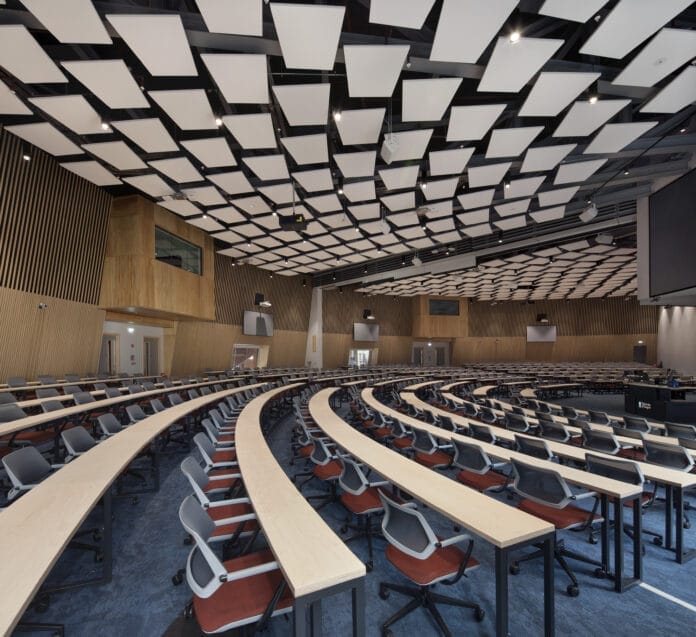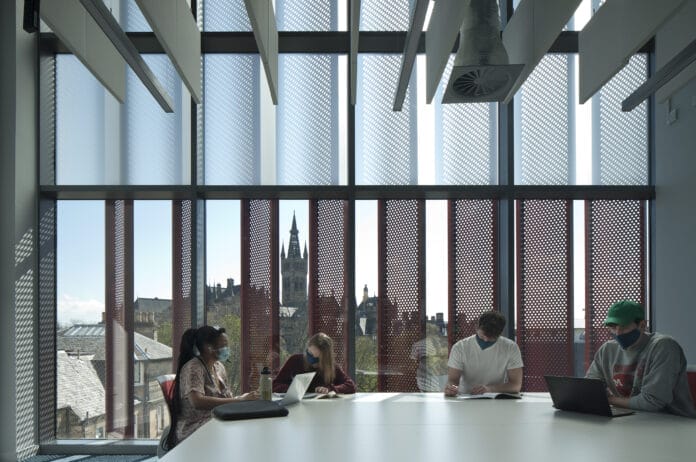
Last week, Lucy Plumridge and Emma-Louise Hannigan attended the AUDE conference, ‘Coronacoaster’, to join the discussion of what the impacts of Covid-19 could be on the future of Higher Education. Hosted by Sir Robert McAlpine, the session brought together a small panel of industry experts to share their thoughts on where we could see Higher Education learning being conducted in years to come which was presented to an audience of 100 industry professionals in a pecha kucha presentation.
Little has changed in learning spaces over the last 1500 years. As we emerge from a post pandemic haze and begin to navigate the path towards a healthier campus, we must consider the future of the traditional lecture theatre.
Covid has truly focused our need to evaluate their place on the campus of the future as we ask ourselves why don’t they serve today’s students?
Rather than promoting collaboration, traditional lecture theatres are passive and do not encourage interaction. They are detrimental to student engagement and fail to foster deep learning or account for the varying learning speeds of students and as such, are largely unsuited to the introduction of new content. As many Higher Education Institutions begin the roll out of NZEB campuses, half capacity, fully serviced lecture theatres are no longer acceptable. It is imperative that education providers look at providing a rich tapestry of learning spaces that caters to and fully supports the diverse cohorts’ sizes and delivery methods that make up today’s education experience.
As education providers strive to enarm students with the soft skills and lateral thinking required of today’s graduates, we must reassess not only how students learn but also how they would like to learn. How can we build more flexibility into the education offering to further support the increasingly diverse cohort that make up today’s student population? Offering students greater choice in how and when they learn can only serve to create more accessible, inclusive Higher Education environments.
With the pandemic bringing re-utilisation of space and time into the forefront of people’s minds, the big question is, ‘Is the future of Higher Education virtual?’. We need to consider the need for flexible learning environments – both virtual and physical – and the impacts that these have on student life, learning and overall experience.
Covid has focused the need for education providers to look at alternative methods of delivery. The last 18 months have seen the majority of Higher Education move online, with students attending lectures and group discussions from the comfort of their home – and often their bed. To some, this may seem the ideal learning scenario, however we have to ask – what do students really want from a University experience? It’s more than intellectual development, improved career prospects and salaries; going to university is about a student’s social and emotional development.
Mental health, specifically the impact of isolation from others on mental health, has been largely reported in light of the Covid crisis across the globe – the National Union of Students survey in September 2020 reported that over 50% of student said their mental health has declined during the pandemic. How, then, can we facilitate the need to learn across flexible platforms, as well as maintaining the many benefits that traditionally come with the university experience?
As part of our briefing for the new James Smith McCune Learning Hub (JMSLH) for Glasgow University, which recently opened its doors to a limited number of students, we surveyed 1700 students and found that they actually like traditional lecture spaces, but do prefer more flexible agile arrangements. The challenge therefore becomes allowing independence, space for individual creativity and disciplined learning where required, while balancing this with an environment that encourages belonging, connectivity and collaborative working. The need for spaces that allow for mass lecturing remains, but other factors have become prominent, for example the blend of formal and informal teaching arrangements. Power and high-speed connectivity are also key for an age where all students have at least one device each, which are used for notetaking in physical classes as well as virtual attendance of lectures from home.
When designing JMSLH, we looked at many examples, including fixed swivel chairs and booth seating, and travelled to Australia and America to look at contemporary learning models. Key features that we learnt from this were flexibility in use, using a shallow rake or flat floor, introducing daylight where possible, and creating dynamic spaces.
From this, we concluded the most flexible arrangement was a double-tier shallow raked lecture theatre that combines a traditional forward facing lecture style with the opportunity for more collaborative group working. This picks up on Blooms Taxonomy of Learning, and Jerome Bruners research into how intellectual ability develops from simply acquiring information to being able to use that to make evidence-based judgements.
New generation large format learning spaces must be supported by a compliment of appropriately sized and arranged formal learning and teaching spaces and informal learning spaces that further enhance the student experience. Emma-Louise has worked with many of the leading Australian Universities over the last decade, implementing spaces that support student centred learning, enquiry and activity-based learning, peer to peer learning and the flipped classroom. There are many considerations in creating successful flipped, active learning environments. Furniture design, provision of power and data, technology enriched spaces, acoustic design, writable surfaces, fixed versus flexible furniture arrangement, the provision (or not) of lecterns are all critically important decisions in designing future enabled learning and teaching spaces. We also need to consider how students will be examined or assessed in these spaces. With most of today’s students bringing their own device or having access to one, do we need to allow for a power point per student in classrooms to enable assessment with the assistance of their device? Provision for the teacher at the centre of the classroom or in a roving capacity rather than at the front of the room ensures closer proximity to students whereby the teacher can act as a facilitator to discussion, give more tailored advice and bring their expertise to the learning table in an informed manner makes for a more enriched learning experience for all students.
With an ever-increasing spotlight on space utilisation across HE campuses, we need to ensure we are truly sweating all the assets. Where there is still a requirement for auditorium and amphitheatre spaces, let’s unlock the doors and make them work harder. Let’s ensure they are part of the new learning landscape that supports informal learning outside of timetabled utilisation. Let’s open the doors that have been previously closed, and allow students to come together outside of class time to catch up on what has been taken away from them over the last 12 months – human connection, a shared experience, a break from the confines of their dorm in new covid safe campus.




